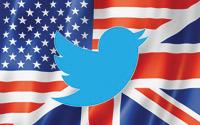UK Twitter Users More Restrained, Positive Than U.S. Counterparts
- by Mark Walsh @markfwal, July 22, 2013

If the U.S. and England are two countries separated by a common language, the cultural gap implied by the famous quip appears to extend to Twitter as well.
A new study by digital agency 360i suggests that U.S. Twitter users are more focused on self-expression and validation, while their counterparts across the pond are more interested in connecting with others through the microblogging service. Marketers, in turn, should consider these differences when planning Twitter campaigns.
The 360i findings are based on a randomized sample of 400 Twitter posts, representing the population of public Twitter interactions in the UK and the U.S. The agency also conducted in-depth online interviews with Twitter users from both countries.
Specifically, 36% of UK users engaged in back-and-forth conversations using the @reply feature compared to only 15% in the U.S. Americans, meanwhile, are nearly twice as likely to retweet content from friends, celebrities or brands and “love to share their opinion about anything -- even without being prompted,” according to the report.
That means marketers have to work harder on providing “talkability” value, or delivering interesting and engaging content, to UK consumers -- since they are not as apt to be seeking validation on Twitter as American users. In other words, the bar is higher for ad content when it comes to reaching Brits.
As one might expect, American Twitter users were also more likely to express raw emotion -- especially anger and frustration -- than those in the UK Brits are generally more positive, with 40% of tweets expressing “joy” compared to 30% on the American side. Brits find happiness in holidays, hobbies and drinking, while Americans love hanging around the house and sports.
“Authenticity is a big factor in how brands approach consumers in the U.S., so quips about common frustrations can help make brands more relatable,” advises 360i. They can take a similar approach in the UK, but should adopt a more positive tone.
Americans are also more opinionated about brands on Twitter, and more likely to complain if they have had a negative experience. As a result, U.S. and UK audiences should be held to different standards. So brands shouldn’t necessarily overreact to getting bashed on Twitter in the U.S., just as a lack of overt affinity doesn’t mean that UK users don’t care about a brand.
Overall, there wasn’t much difference in brand mentions as a share of Twitter conversions on either side of the Atlantic, at 5% in the U.S. to 6% in the UK.
On a more practical level, the study found Americans are more active on Twitter in the evening, while people in the UK tend to tweet throughout the day, with the lunch break a popular time for using the service. So the timing of marketing efforts could be aligned accordingly.
The U.S. still had nearly four times as many Twitter users as the UK -- at 36.8 million to 9.9 million, according to eMarketer figures as of February 2013.
But the company said at the start of the year that 70% of its then-200 million accounts were outside the U.S., with advertising available in more than 50 countries. As marketers expand the scope of Twitter campaigns, tailoring efforts to different regions and countries becomes incresingly important. Even between those with long historic and cultural ties like the U.S. and the UK.


